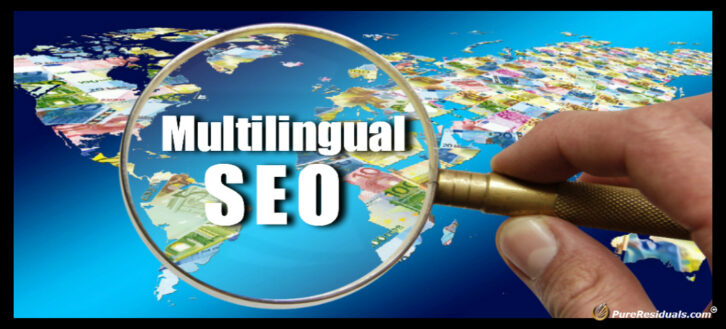At some point, you will have foreign visitors to your website, if only because it is now so easy to purchase products/services from anywhere in the world. And you may be thinking about pursuing new markets either among foreign-speaking populations within your own country or in direct markets in other countries. And if you do this, you will want your website, your blog, and other content “localized” for those demographics.
Localization simply means translating your website and other content into foreign languages with mindfulness of cultural uniqueness and biases.
But you want more than that. You want to maximize that translated content for SEO, just as you have done with your current one.
Important Considerations
Getting it right will require some thought, some time, and the right resources, including:
- Selecting the best content management system (CMS) and site structure
- Researching the best and most relevant keywords/phrases in the target language – those that have high search volume
- Getting the right resources to actually translate your site, along with at least some of your blog pages and/or other shareable content.
- Participating in country-specific social media channels to boost brand awareness and content that is linkable and will boost search engine rankings.
- Crafting a plan to promote your site through link building in the target language
The above are all also budget considerations because chances are you do not have the expertise in the target language to do this yourself. And if you are going to have a site that performs as well in another language, you will need to hire that expertise. Depending upon your budget, you may want to choose one demographic/language at a time, making sure that one is ranking well before moving on to another.
Getting more specific, here are the steps/decisions to be made:
Using Existing CMS or Opting for a New One
There probably needs to be a conversation with a developer, if you do not have expertise in this area. You may have an amazing site in English, but if an entirely new database will be required to translate that site into another language, it may be time to reconsider a re-design of your existing site with a different CMS. There is a number that will allow you to create websites in multiple languages with a shared database, and there are certainly advantages to this.
- Changes and updates will all be accomplished at the same time
- Hosting space is reduced, and that can be less costly.
- Stock control is possible across multiple websites
WordPress, Drupal, Joomla, and Magento all make creating websites in multiple languages pretty easy. If your original site does not use one of these, it may be time to make the switch. If it does, though, your project will be much easier. If your current CMS only supports one language, and you want to keep it, be mindful that you may be able to copy it and then have it translated, but you will have two separate databases as a result, and changes and updates will require two separate tasks each time.
Options for Structuring Your Website
The question here is related to domains. And you do have several options. For example, you can use “.com” which is rather universal, or you can use country-coded top-level domains (e.g., .fr for France or .de for Germany). You can also use sub-domains or sub-folders on a top-level global domain. Using top-level country coded domains for each target language does have some advantages, particularly if you are targeting demographics within countries, rather than just different languages within the same country.
- They are targeted to the specific country and will receive a boost in ranking from that country.
- Even demographics within your country whose native language is French, for example, will often search for websites with a .fr domain for a language-friendly site.
- If your domain name is keyword-rich, translating it for each country provides great generic searchability.
HREF Lang Tags
These tags will alert Google relative to which language-specific pages are written in. If you have one of the above-mentioned CMS systems, each page is easily configured in its own language, although it is best to check and be certain that those pages are configured correctly. If you do not understand Hreflang tags, you may want to research them a bit more.
One important thing to remember: search engines do not like pages that are in more than one language – it’s confusing. Each page should have its own language-specific URL and all content on the page should be in that language.
Multilingual Keyword Research
This is a critical factor in SEO optimization for multilingual sites, as you probably already know. This requires time and research, to determine which keywords are the high volume in the target language, so they can be included in your pages and in your backlinks.
You can do Google keyword research for almost 30 countries, and this will certainly provide valuable direction. However, you may want to consult with a native speaker before you simply have your keywords translated into a foreign language. Consider this example:
You have an international vacation rental website that features rentals all over the globe. You obviously want to appeal to an international audience, and so you have your website translated into a number of languages with country-coded top-level domains. You may be performing well in France with a keyword of ‘location vacancies.’ But your performance in the UK is poor. Why? Because in the UK, vacation is not a high-volume search term. “Holiday” is. Your keyword phrase should be “holiday rentals.” A Google search for high volume keyword terms may give you this, but it is best to check with a native speaker too.
Your research goal is to determine the high-volume keywords and keyword phrases in each language/country that will perform well for searches in those countries. Once you have those, you are ready to craft the website translation.
SEO Site Translation
Your translation can take two avenues: you can have the translation completed and make sure the target content is optimized as the translation is crafted, or you can have a standard translation competed and the go back and optimize the new content with the keywords/keyword phrases.
The best way to do this is to create a chart or a spreadsheet – one that shows the English keyword or phrase and the target language keyword/phrase you will be using. And here is where expertise is really necessary. Those keyword phrases may have to be conjugated or adapted to fit the translation content, and it is important that this be done properly. Again, get the expertise you need. Keywords and keyword phrases need to flow naturally within the content just as they should in English.
The Issue of Grammatical Correctness
Keyword research often brings up phrases that are not grammatically correct. This is because people who conduct searches often use shortened forms – “Restaurants New Orleans” is a good example.
Content writers used these incorrect phrases in order to get more hits and rank higher, but it made their sentence structures awkward or just plain bad. Google now penalizes for this if they occur in the content itself. But, it is perfectly fine to use them in URL’s, Meta tag titles and anchor text for menu links. Even in translation, try always to use correct grammar, unless there is a huge difference in volume, and the poor one wins by a landslide.
Link Building
Much of the link building strategies you already use are the same with multilingual links.
- Search in Google for specific keywords in your target language. Then, submit articles and/or ads to blogs, forums, other ad sites, and directories that are on the first couple of pages. Be certain that each article is unique.
- Search the backlinks that your competitors are getting in the target language and submit content with your own.
- Don’t try to manipulate anchor text, such as using French anchor links to something in English. Google penalizes this activity.
It Can Be Complicated
Even if you have expertise in a language, translating a website and other content, taking into account social and cultural factors in those translations, and, as well, using effective strategies for SEO, take more than just language fluency. It requires skills in design and development, content marketing, and SEO experience in keyword research, adaptation, and link building.
Most business owners who are looking to spread their brand through foreign language site development use pros who have a successful history in both site development and the target language. If you have any question about your skills, don’t take the chance. Get the help you need. If you do go it alone, carefully consider the seven steps above. You don’t want your time and money wasted, and you do want to generate revenue from your new audience.
About the Author






